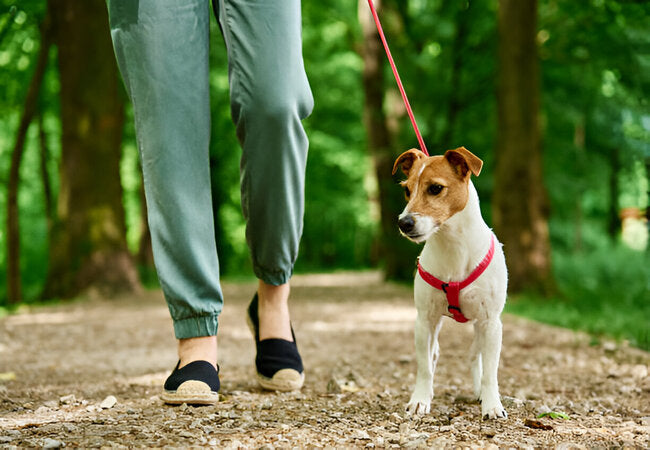Leash Training Dogs: 2025 Vet-Approved Guide to Polite Walking 🐕🦮

In this article
🐾 How to Leash Train Your Dog in 2025: Master Loose-Leash Walking, Polite Pull-Free Strolls & Confidence-Building Tips
By Dr. Duncan Houston BVSc
👣 Why Leash Training Matters
Teaching your dog to walk politely on a leash creates safer, more enjoyable outings, strengthens your bond, and helps prevent injuries. Pull-to-run behavior can cause leash-tug injuries, neck issues, and stress for both of you.
🧰 Gear Up: Choose the Right Equipment
- Non-retractable leash: Start with a 4–6 ft leash; consider 10–30 ft long-line for training flexibility.
- Harness vs collar: Harnesses distribute pressure, ideal for neck-sensitive dogs; head halters (e.g. Gentle Leader) gently guide head, preventing pulling.
- Treat pouch & markers: Keep high-value treats at hand plus a clicker or marker word (“yes!”) to reinforce good walking behavior.
🔄 Step 1: Off-Leash Guidance Indoors
Begin in a quiet, safe space. Place a treat on the ground, then walk away slowly. When your dog follows and the leash is slack, click or say “yes!” and reward.
Gradually increase walking distance—1 step, 3 steps, 5 steps—rewarding generously each time your pup keeps up without pulling.
➤ Step 2: Introduce Harness & Leash
Let your dog explore the leash and harness at their own pace—smell it, wear it indoors, and enjoy treats. Start with short “gear time” sessions before walking begins.
Once relaxed, attach the line and repeat the indoor walking game, rewarding pocket attention and loose leash movement.
🚪 Step 3: Making the Move Outdoors
Choose a low-distraction zone—like your yard or a quiet street. Allow sniffing freedom while the leash is loose. When ready, call their attention, then walk. Reward every time your dog pays attention and keeps slack in the leash .
Maintain frequent markers during initial walks—every 2–3 steps early on, then gradually reduce.
🎯 Step 4: Practicing “Follow Me” and Attention Games
Play the “follow me” game: step backwards, say “yes!” when they follow, then treat. Repeat 8–12 times. This helps build engagement and leash responsiveness.
Teach “look at me” or “touch” to break pulling habits. Pause if they pull until they respond to cue—then reward and proceed.
🛑 Step 5: Handling Pulling Behavior
When your dog pulls, stop immediately. Use “look at me” or “touch” to regain focus. Reward once attention returns and leash slackens .
Remember: pulling = slow walk or stop. Loose leash = movement forward and praise.
🐕🦺 Step 6: Manage Leash Reactivity
For dogs anxious or reactive while on-leash:
- Define a **buffer zone**: stay far enough from triggers so your dog remains calm.
- Mark & treat when they notice triggers calmly—build a positive association.
- Gradually close distance only if they stay relaxed and engaged—not too quickly.
This gradual desensitization helps build confidence and civility on walks.
📆 Step 7: Practice in Real-World Settings
Move to busier environments once loose-leash at home and yard are consistent. Continue reinforcing attention, loose leash, and use of attention cues amidst distractions.
Avoid overwhelming situations; break practice into short, consistent sessions for best success.
💡 Tips & Troubleshooting
- 🎯 Stay calm—your dog's reward is your presence, not frustration.
- 🍗 Use high-value treats (chicken, cheese) during training phase.
- 🔁 Consistency is key—don’t reinforce pulling by allowing forward after a pull.
- ⏳ Break training into 5–10 minute sessions, multiple times daily.
- 🏋️♂️ Sometimes physical exercise before training helps—tired dogs learn easier.
🎒 Recommended Gear: Leashes & Harnesses
Experts recommend padded, dual-handle leashes for control, reflective options for night walks, and head halters for pullers.
Choose equipment that suits your dog’s size, strength, and anatomy (neck, shoulder issue considerations).
🧸 Boost Training with Ask A Vet, Woopf & Purrz
- 🩺 **Ask A Vet**: Access personalized guidance on equipment choices, leash reactivity, and behavior assurance from pros in real time.
- 🎾 **Woopf**: Durable treat-dispensing toys and training tools keep your dog motivated and focused on you during walks.
- 🍃 **Purrz**: Probiotic chews support digestive calm—especially important before outings to avoid tummy troubles mid-walk.
🏁 Final Thoughts
Leash training is a journey—start slow, remain consistent, and celebrate small wins. With the right gear, patience, and engagement-focused methods, your dog can learn to walk calmly by your side.
Remember: practice in varied environments, reinforce attention, and seek help from Ask A Vet if challenges arise. Soon, you’ll enjoy relaxed, confident strolls together—pull-free and pleasurable. 🌟
— Dr Duncan Houston, BVSc
Ready for personalized advice or troubleshooting? Visit AskAVet.com and download the Ask A Vet app for tailored support 24/7.






